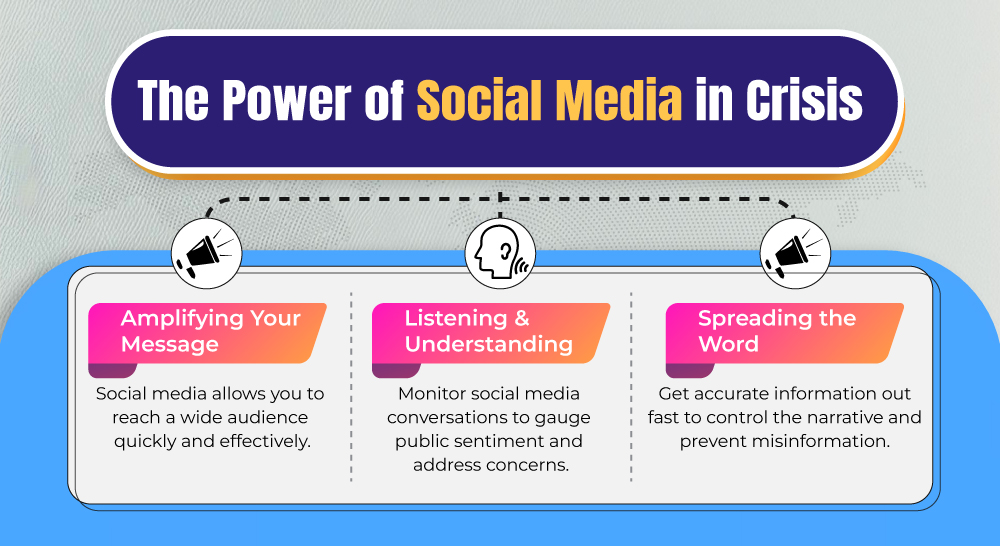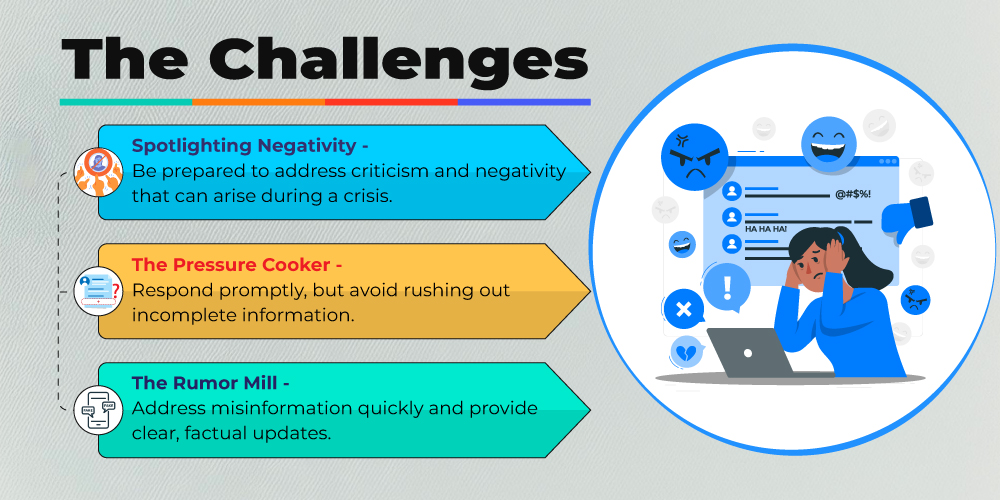Social Media in Crisis: Your Lifeline or Landmine?
In today’s hyper-connected world, a crisis can explode from a minor issue to a full-blown public relations nightmare in a matter of minutes. But amidst the chaos, social media emerges as a double-edged sword. It can be your lifeline for getting accurate information out and managing the narrative. However, a misstep can turn it into a landmine, amplifying negative sentiment and damaging your reputation.
So, how do you leverage social media for effective crisis communication?
The key lies in proactive planning and understanding the unique strengths and challenges this platform presents.
The Power of Social Media in Crisis


Imagine a crisis unfolding – a product recall, a data breach, or a customer service mishap. Social media allows you to:
- Spread the word quickly: Unlike traditional media channels, social media lets you disseminate accurate information to a wide audience instantly. This helps control the narrative and prevent misinformation from spreading. With millions of users active on platforms like Twitter, Facebook, and Instagram, news and updates can be shared instantaneously, reaching a vast audience within seconds. Official accounts of individuals or organizations involved in managing the crisis can disseminate real-time updates, instructions, and safety measures, ensuring that accurate information reaches those affected swiftly. Moreover, features like hashtags and trending topics allow users to track and follow relevant updates, enhancing the reach and visibility of critical information.
- Build trust and transparency: Open communication through social media fosters a sense of trust with the public. By providing transparent updates, acknowledging challenges, and addressing concerns openly, individuals and organizations can demonstrate their commitment to accountability and integrity. Engaging with followers through comments, direct messages, and live streams humanizes the crisis response, making it more relatable and trustworthy. Moreover, sharing behind-the-scenes insights into crisis management efforts can enhance transparency, reassure the public, and strengthen their confidence in the authorities’ ability to handle the situation effectively.
- Listen and understand: Social media listening tools allow you to monitor conversations and gauge public sentiment. This real-time feedback is invaluable for tailoring your communication strategy and addressing specific concerns. By tracking keywords, hashtags, and mentions, stakeholders can gain valuable insights into how the crisis is perceived, identify emerging issues, and address misinformation promptly. Analyzing sentiment analysis metrics, such as positive, negative, or neutral mentions, allows for a nuanced understanding of public perception. This enables tailored communication strategies to address specific concerns and alleviate anxieties effectively.
- Mobilize resources: In times of crisis, social media can be a powerful tool for rallying support. Individuals and organizations can leverage their social media presence to call for volunteers, donations, and assistance, tapping into the collective goodwill of their followers and networks. Crowdfunding campaigns, donation drives, and volunteer recruitment efforts can gain momentum quickly through social media shares, likes, and retweets, amplifying outreach and maximizing impact. Additionally, social media platforms facilitate direct communication between those in need and those offering support, streamlining and connecting resources with the affected communities.
The Challenges: When Social Media Goes Rogue


While social media offers immense benefits, it also presents significant challenges:
- The rumor mill: False information and rumors can spread like wildfire on social media. In times of crisis, it is essential to promptly address misinformation and provide clear, factual updates to prevent the spread of rumors and maintain public trust. However, distinguishing between truth and falsehoods can be challenging amidst social media’s chaos. Therefore, diligent monitoring, fact-checking, and swift corrective action are necessary to ensure accurate information prevails.
- The negativity wave: Social media platforms can serve as breeding grounds for negativity, amplifying emotions and inciting online attacks, backlash, or boycotts. Criticism and backlash during a crisis are almost inevitable, but it’s essential to handle them constructively, maintain a calm, professional demeanor, and respond thoughtfully rather than defensively. Engaging with stakeholders respectfully, addressing legitimate concerns, and demonstrating empathy can help defuse tensions and mitigate the impact of negative sentiments on reputation and credibility.
- The pressure cooker: The 24/7 news cycle demands instant responses. However, succumbing to the pressure to respond hastily can be counterproductive, particularly when information is still evolving or incomplete. Rushing to provide updates or statements without verifying facts thoroughly can exacerbate the situation, leading to misinformation or unintended consequences. Instead, prioritize accuracy and reliability over speed. Verify information before communicating with stakeholders to ensure credibility and trustworthiness.
Social Media Success Stories
- Lululemon: In 2013, the yoga apparel brand faced a PR crisis after recalling yoga pants due to sheerness concerns. Lululemon’s CEO took to social media, acknowledging the issue and outlining corrective measures. The brand’s transparency and focus on customer safety were well-received, minimizing long-term damage.
- Airbnb: Airbnb faced a crisis when a host’s home was vandalized by guests. Airbnb swiftly responded via social media. They expressed condolences, offered support to the victim’s family, and outlined safety protocol updates. Their prompt and empathetic communication helped maintain user trust.
- Starbucks: In 2018, Starbucks faced a public outcry after two black men were arrested at one of its stores. The company responded with a public apology, store closures for racial bias training, and engaging with community leaders. Starbucks’ proactive response demonstrated a commitment to addressing systemic issues and rebuilding trust with customers.
The Cautionary Tales
Examples abound of brands fumbling social media responses during crises. A delayed response, lack of transparency, or dismissive tones can exacerbate the situation and permanently damage the brand’s reputation.
- United Airlines: In 2017, United Airlines faced severe backlash over a viral video showing a passenger being forcibly removed from an overbooked flight. The company’s initial response was criticized for being tone-deaf and lacking empathy. United’s mishandling of the crisis resulted in significant damage to its reputation and financial losses.
- Pepsi: In 2017, a controversial Pepsi ad featuring Kendall Jenner sparked accusations of trivializing social justice movements. Pepsi’s response to the backlash was seen as inadequate, leading to widespread criticism and the eventual withdrawal of the ad. The incident damaged Pepsi’s brand image and emphasized the need to consider social and political sensitivities in marketing campaigns.
Managing Your Online Reputation During a Crisis
Here’s how to navigate a social media crisis with your reputation intact:
- Be prepared: Don’t wait for a crisis to strike. Develop a crisis communication plan that outlines designated social media responders, pre-approved messaging templates, and clear escalation procedures.
- Embrace transparency: Honesty is the best policy during a crisis. Acknowledge your mistakes, take responsibility, and communicate a clear plan for rectification.
- Respond swiftly and with empathy: Address concerns promptly, showing genuine empathy for those affected.
- Humanize your brand: Ditch robotic language. Use genuine expressions and a conversational tone to connect with your audience.
- Monitor and engage: Actively monitor social media conversations and engage with the public. Respond to comments, answer questions, and address concerns directly.
- Learn and adapt: Every crisis is a learning experience. Analyze what went well and what went wrong. Use these insights to improve your communication strategies for future situations.
In today’s digital age, a crisis can unfold and escalate in a blink of an eye. Social media presents a unique opportunity to manage these situations effectively. But remember, true crisis communication goes beyond damage control. It’s about building trust, fostering empathy, and demonstrating your brand’s commitment to transparency.
By prioritizing genuine communication and human connection, you can transform a social media crisis into a catalyst for strengthening your brand reputation.







